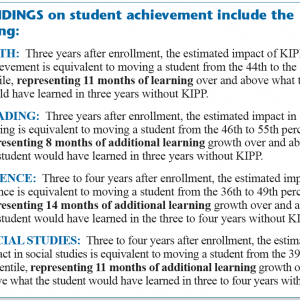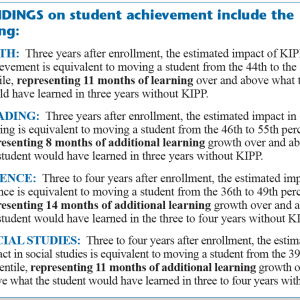Mathematica Policy Research, a nonpartisan research firm, has released a new study of KIPP middle schools. The study, funded by Atlantic Philanthropies, found that “The average impact of KIPP on student achievement is positive, statistically significant, and educationally substantial.” According to the authors, the study found that
KIPP middle schools have positive and statistically significant impacts on student achievement across all years and all subject areas examined. In each of their four years of middle school, KIPP schools produced positive academic impacts on state standardized tests. Significant positive impacts are evident on average as well as for the majority of individual KIPP middle schools in the study.
The magnitude of KIPP’s achievement impacts is substantial. In each of the four subjects studied, KIPP schools produced achievement gains large enough to have a substantial impact on student outcomes:
- Math: Three years after enrollment, the estimated impact of KIPP on math achievement is equivalent to moving a student from the 44th to the 58th percentile of the school district’s distribution. This represents 11 months of additional learning growth over and above what the student would have learned in three years without KIPP.
- Reading: Three years after enrollment, the estimated impact in reading is equivalent to moving a student from the 46th to the 55th percentile, representing 8 months of additional learning growth over and above what the student would have learned in three years without KIPP.
- Science: Three to four years after enrollment, the estimated impact in science is equivalent to moving a student from the 36th to the 49th percentile, representing 14 months of additional learning growth over and above what the student would have learned in that time without KIPP
- Social Studies: Three to four years after enrollment, the estimated impact in social studies is equivalent to moving a student from the 39th to the 49th percentile, representing 11 months of additional learning growth over and above what the student would have learned in that time without KIPP.

The matched comparison design produces estimates of KIPP’s achievement impacts similar to estimates of the same impacts based on an experimental, lottery-based design. Researchers found that KIPP’s achievement gains are similar for the matched comparison design and the experimental lottery analysis.
KIPP’s gains are not the result of “teaching to the test.” For KIPP students in the lottery sample, researchers administered the TerraNova test—a nationally norm-referenced test—which students had not prepared for, and which carried no consequences for students or schools. The impacts shown in the TerraNova test were consistent with those shown in state tests.
You can read the Executive Summary here and the full report here. A fact sheet is here.



